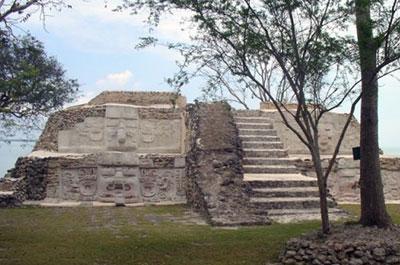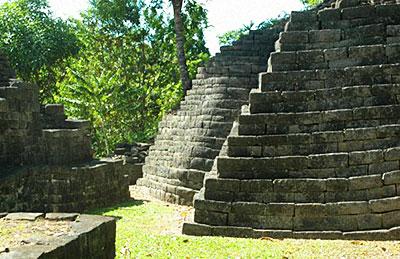PART. 2
6. Lamanai
Lamanai is the Maya word for "submerged crocodile." The site's name - "Lamanay" or "Lamayna" was recorded by Franciscan missionaries in the seventeenth century. It is one of the only sites retaining its original name and is among one of Belize's largest ceremonial centres. Most folks visit Lamanai by road through San Felipe, Orange Walk, rather than by boat. A "jungle cruise", the road trip is an excellent chance to see birds, exotic plants and crocodiles. The site itself is even more spectacular; situated on a major trade route, Lamanai is one of the longest occupied Mayan cities and was inhabited for over two millennia. Lamanai has more than 719 mapped structures, including two 16th century Christian churches as well as an intact 19th century sugar mill. Due to the extraordinary length of time that Lamanai was occupied, one can explore several periods of Maya construction techniques, from the Classic Period to the Post Classic.
7. Cerro Maya
From 400 B.C. to 100 A.D., Cerros, or Cerro Maya, was a pivotal coastal trading center. With a Spanish name that translates to "Maya Hill", Cerro Maya is located on a peninsula across from the town of Corozal and in the Bay of Chetumal. Archaeologists believe Cerros must not have survived long because of a shift in trade routes. At the height of its day, the city distributed salt from mining communities and traded chert tools. Today, Cerros is partially underwater, but what remains is stunning – including five temples (one that is 72 feet high) and related plazas, a large canal system and a beautiful panoramic viewed from the top of the temples.

Cerros was occupied in the late Preclassic period and underwent several modifications in the Classic period. For much of its history the site was an important trading center probably based on this sea-borne import of jade and obsidian. Its early decline was possibly few to the general shift of trade routes connecting the highlands and lowlands in the early classic.
This Cerro Maya (Maya Hill) archaeological reserve comprises 52 acres and includes 3 large architectural complexes dominating several plazas flanked by pyramidal structures. Tombs and ball courts have been excavated and artifacts found within them attest to the importance of the site between 400 BC and A.D. 100. This site’s proximity to the sea has resulted in the erosion of two large structures. One of these mounds, structure 5C-nd, contains large stucco masks that have now been replicated to the Institute of Archaeology.
Thomas Gann was among the first to recognize the existence of Cerros, but it was not until 1969 that keep their Peter Schmidt and Joseph Palacio visited the site and registered it with the Institute of Archaeology. The land on which the site is located was originally acquired by a Dallas-based company, Metroplex Properties. They subsequently established a nonprofit organization known as the Cerro Maya foundation whose purpose was to excavate the ceremonial center as a tourist attraction. Thankfully the foundation went bankrupt and the large-scale development of the site never materialized. Cerros was eventually surveyed, excavated and partially consolidated from 1973 to 1979 by David Freidel of Southern Methodist University. Freidel focused on the ceremonial center, and on the importance of trade at Cerro Maya. More recently the Belize Institute of Archaeology has conserved the Preclassic masks exposed my Freidel in the 1970s.
8. Barton Creek Cave
Barton Creek is one of the most popular tourist destinations in the Cayo District. In addition to its natural beauty, the site contains a wide range of cultural remains that were left within the cave as offerings by the ancient Maya. Artifacts, hearths, modified cave formations, and human remains were deposited on ledges above the river indicating that the cave was of great ritual importance to the ancient settlers of the region.
9. Nim Li Punit
The name Nim Li Punit is derived from a carving on one of the site's twenty six stelae, which depicts a figure wearing a large headdress. In the Maya Kekchi language, Nim li Punit means "the big hat." The monument on which this carving appears is the longest stela in Belize (Stela 14), originally located in an area called Plaza of the Stelae. These ruins over look the Toledo coastal plain, milpas and rain forest. Having only one main plaza, one pyramid, one ball court and a few moderately sized buildings, Nim Li Punit fall is smaller compared to masterpieces found in other areas of Belize. But it has a large number of stelae; twenty-five large, often huge, stone slabs and pillars, eight of them carved, populate this small area. In fact, one of the stela is the tallest carved example in Belize. Due to this curiosity, Nim Li Punit is believed to have served as its dynasty's worshiping place.
10. Lubaantun
"Place of the Fallen Stones". This Late Classic ceremonial center is noted for its unusual style of construction distinctive of southern Belize. The large pyramids and residences are made of dressed stone blocks with no mortar binding them together. The buildings on top of the pyramids were made from perishable materials rather than masonry and hence do not remain. The name is Maya for "Place of Fallen Stones. Lubaantun is located north of the Colombia River, one mile past the village of San Pedro Colombia, in the Toledo District.
